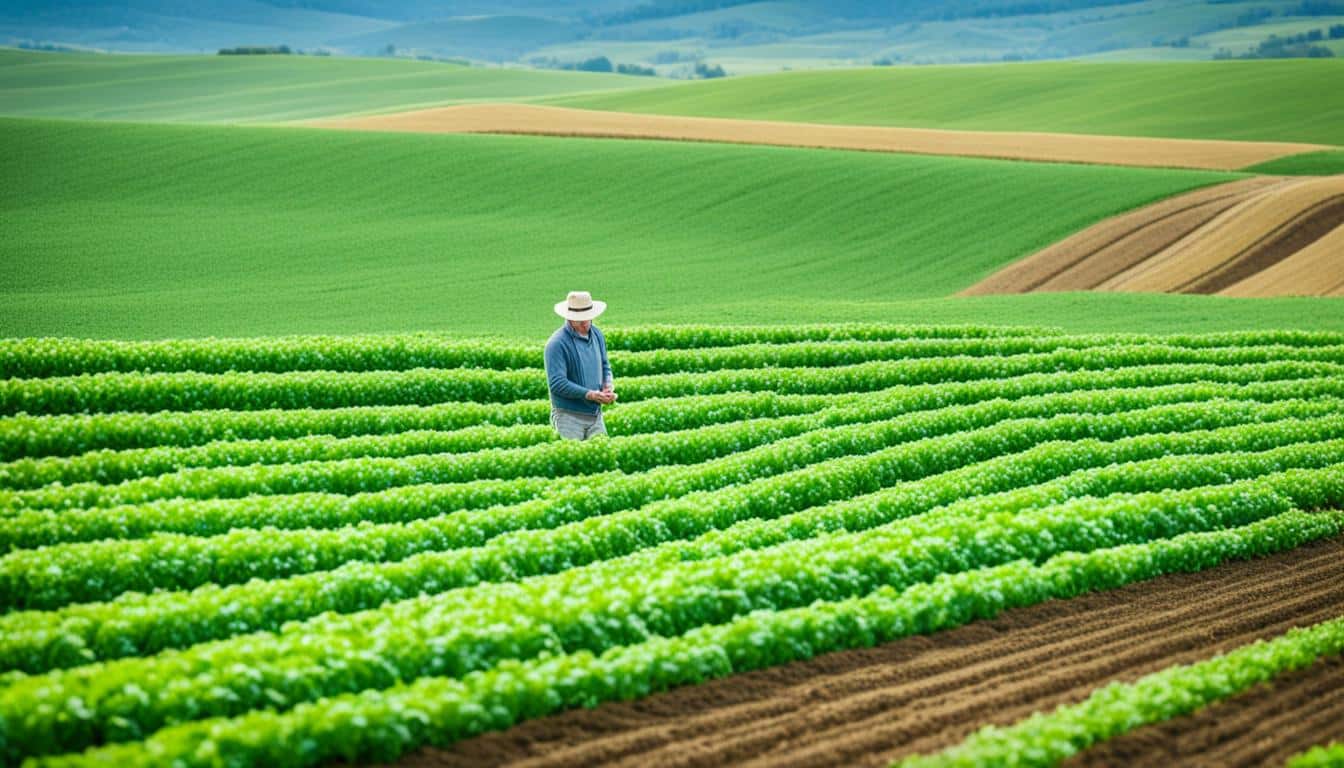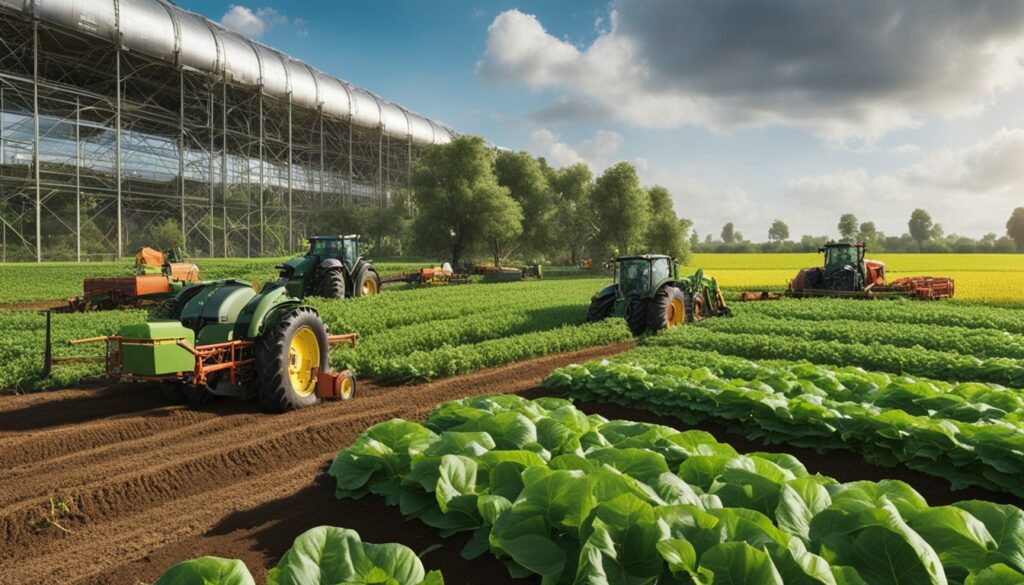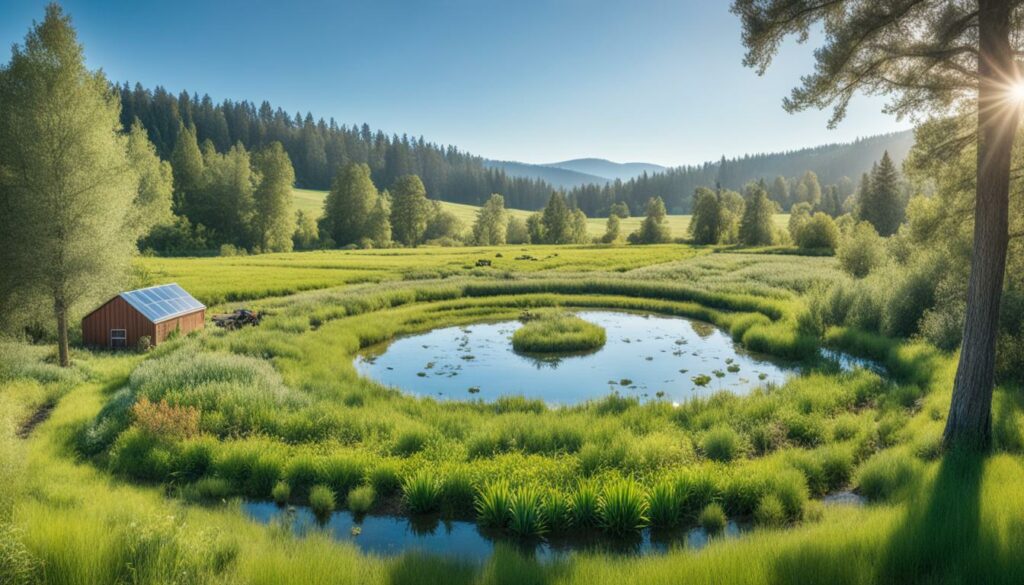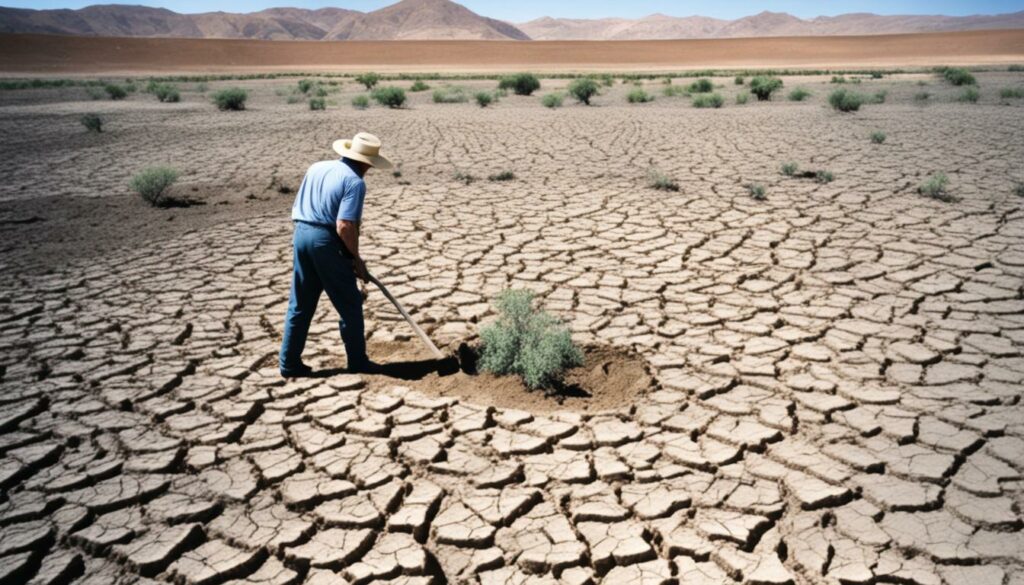Menu

Did you know the agriculture sector makes up 23% of greenhouse gas emissions worldwide? This sector also accounts for 8-10% of emissions through food waste. However, there’s hope in regenerative agriculture for a sustainable future.
Regenerative agriculture is a sustainable farming approach. It boosts soil health, increases biodiversity, and strengthens against climate change. This method fights soil degradation, water scarcity, and climate change, making it key in sustainable farming ecosystems.
In regenerative agriculture, we avoid disturbing the soil. We use cover crops to stop erosion and reduce the need for pesticides and fertilisers. These steps not only keep ecosystems strong but also cut down on harmful emissions.
Farmers who switch to regenerative farming can earn extra money from carbon credits. This extra income helps support sustainable farming. Using these methods, we can build a food system that is both strong and eco-friendly, ensuring a better world for future generations.
Regenerative agriculture changes the way we see farming. It treats agriculture as part of a whole system. It’s deeply connected to nature. This approach works to make soil and ecosystems healthy. It also tries to fix old problems in farming and looks to the future with hope.
Regenerative agriculture is more than farming practices. It’s a way of thinking and acting. It combines organic farming and agroecology. This mix helps farms work in harmony with nature. This process helps soils heal, increases biodiversity, and cuts down on water pollution. In this setting, plants, animals, and people can support each other. Indigenous peoples have done this for ages. They show us how to farm in ways that don’t harm the earth.
Modern farming is eroding soil faster than it can form. This is a real danger for our food supply. Regenerative agriculture moves away from harmful chemicals. It cuts down on climate-damaging gases. Also, it makes soil richer and helps against climate change. Big food companies are seeing the benefits. Companies like Nestlé and PepsiCo are investing. They aim to help the environment and farmers at the same time.
Regenerative agriculture focuses on key principles to boost soil health. This helps in making farming practices beneficial for our climate. By following these basic rules, we can make our farms more sustainable and fruitful.
One big rule in regenerative agriculture is to lower soil disruptions. This means doing less tillage or not tilling at all. It’s important for keeping the soil structure healthy and helping soil life thrive. This strategy also cuts down on soil loss and the carbon that goes into the air. So, agriculture becomes kinder to our climate. A stable soil helps create a stronger ecosystem for farmers.

Cover crops, like legumes and grasses, are vital for regenerating soil. They boost biodiversity and make the soil more fertile. Cover crops guard the soil from erosion, stop weeds, and make a home for helpful critters. This balances the ecosystem and leads to soil that can hold more water and nutrients.
Using less pesticides and artificial fertilisers is key for a greener, healthier farm. Regenerative agriculture aims to lower the use of these chemicals. This helps cut pollution and boosts the soil’s natural strength. By using more organic methods, farmers reduce synthetic inputs while keeping their farms productive and profitable.
These practices are crucial for farming that’s good for the climate now and in the future. They help tackle today’s environmental issues and set the stage for a sustainable future.
Carbon sequestration in farming fights climate change. It locks carbon into the ground, lowering the CO2 in the air. This helps stop the earth from getting too warm. Techniques like less plowing, using cover crops, and more plant types are key.
It’s amazing to learn that 133 gigatonnes of carbon have left our soils since we started farming. This loss means we’ve added 480 gigatonnes of CO2 to the air. But, by storing carbon in the soil again, we can fix this imbalance.
Actions like cover crops can really boost carbon storage. In Brazil and Paraguay, over 25 million hectares use green manure and cover crops, thanks to 3 million farmers. In Africa, planting trees on 24 million hectares has brought back life. These cases show how powerful farming can be against climate change.
Managing plowing and having more plant types is very important in capturing carbon. Plowing less keeps the soil’s carbon safe. Yet, we must watch out for using too many chemicals in this type of farming.
Changing which crops we grow, like maize and mucuna in Central America, helps reduce the need for pesticides. It also makes the soil better. Worldly, using cover crops on over 600 million hectares grows by 20 million every year. This shows we can make a huge difference.
It’s predicted that if we farm optimally, we could cut 1.5 gigatonnes of CO2 each year. That’s about 55 gigatonnes in 35 to 40 years. But, we all have to work together to reduce even more carbon to stop global warming from going too far.
In regenerative agriculture, focusing on soil health is key. These methods help create a balanced ecosystem. This leads to more biodiversity and boosts farm productivity.
No-till farming is central to regenerative farming. It keeps soil undisturbed, which is good for its structure. Plus, it boosts the content of organic matter in the soil, crucial for plant growth.
Traditional farming can erode soil faster than it can form. So, by lessening soil erosion, no-till farming is a big win for regenerative farming.

Soil organisms are vital for soil health. They help nutrients move around, break down matter, and make the soil structure better. This network of life supports crops and increases the variety of species.
The connection between no-till farming and these organisms is key. It makes regenerative farming a whole process. This helps farmers build an environment where soil and plants can do well together.
Crop rotation is key in regenerative farming. It helps the soil stay healthy and cuts down on chemicals. It also boosts biodiversity. This approach makes farms better prepared for changes in the weather.
Agroforestry and hedgerows are vital for saving different plant and animal species. Hedgerows make paths for animals. Meanwhile, agroforestry mixes trees and crops to give a variety of wildlife homes.
Using different crops in rotation helps the soil and the environment. It boosts soil health and cuts down on harmful gases. Adding no-till or low-till methods helps fight climate change too.
The IPCC says farming and land use cause about 22% of the world’s greenhouse gases. But if we use methods like crop rotation and agroforestry, we could cut this down. Doing this will help our farms last longer and be better for the planet.
Water conservation is key in regenerative agriculture. It helps farms deal with water scarcity and stay productive. By using sustainable methods, farms improve soil health. This is very important in places where droughts are common.
A number of techniques in regenerative agriculture help save water. One key method is cover cropping, which improves soil and keeps more water. Research shows that increasing soil organic matter just 1% can help store more than 20,000 gallons of water per acre.
Additionally, updating irrigation systems on farms can save a lot of water. These updates could reduce water use by 5-6 million acre-feet each year. In California, the Statewide Water Efficiency and Enhancement Program (SWEEP) has already saved over 117,000 acre-feet through these changes.
Water scarcity is a big challenge that calls for smart solutions. Regenerative agriculture suggests focusing on soil health. Healthier soils don’t need as much water. They can store water better, which helps in times of drought. A 3% increase in soil organic matter might mean needing 584,000 acre-feet less water each year.
A lot of the world’s water, about 70%, goes to agriculture. Switching to regenerative practices can help save a lot of this water. Big companies like General Mills and Kellogg’s are starting to focus on water efficiency. Their efforts show that the business world can make a big difference in saving water. By using these sustainable farming methods, the agriculture sector can work on water scarcity issues and protect the environment too.
| Aspect | Impact |
|---|---|
| Increase in Soil Organic Matter (1%) | 20,000+ gallons of water storage per acre |
| Potential Reduction in Irrigation Demand | 208,000 acre-feet annually (1% increase) |
| Water Savings through Irrigation Upgrades | 5-6 million acre-feet per year |
| Water Efficiency Savings (SWEEP) | 117,000 acre-feet to date |
| Global Agricultural Water Use | 70% of total water usage |
| Corporate Initiatives | Programmes by General Mills and Kellogg’s |
By choosing regenerative agriculture, farmers can see big changes in their income. Right now, only a small part of U.S. farms use these methods. But, the move towards sustainable farming is already bringing good results.

Switching to regenerative ways means farmers might make 15% to 25% more money. Imagine, by changing how they farm, they could earn over $425 more per acre. And while starting this new method can cost $42 per acre, the income can be 120% higher than before.
In California, almond farms that use regenerative methods make twice as much money as traditional farms.
The boost in income doesn’t just come from more crops. Going green can mean spending less on things like fertilisers and pesticides. Farmers have been able to cut their fertilizer use in half and use 75% less pesticide. This was seen on the farm owned by Mitchell Hora in Iowa, who comes from a long line of farmers.
The economic benefits of regenerative agriculture extend beyond direct farm income. Diversification of income sources, like on-farm workshops and direct sales, offers additional revenue streams for farmers adopting these practices.
| Metrics | Conventional Farming | Regenerative Farming |
|---|---|---|
| Initial Cost/Acre | – | $42 |
| Net Income Increase/Acre | – | $425.19 |
| Profitability Increase | – | 15-25% |
| Fertiliser Use | 100% | 50% Reduction |
| Pesticide Use | 100% | 75% Reduction |
It’s not just that it costs less to farm. Choosing greener methods also means more jobs in areas like food processing. As more people want organic food, these sectors grow. Plus, help from experts and money from the government makes it easier for small and new farms to change their ways.
Our move to sustainable farming means cutting back on synthetic inputs. This change is vital for healthy soil and a balanced environment. Organic methods are key to achieving this.
Going organic reduces our need for chemical fertilisers. Farmers can boost soil health naturally with compost and green manures. This method also encourages the growth of helpful microorganisms.
| Parameter | Chemical Fertilisers | Organic Fertilisers |
|---|---|---|
| Cost | Higher initial cost | Lower initial cost, long-term savings |
| Soil Health | Degrades over time | Improves over time |
| Biodiversity | Negatively impacted | Positively impacted |
Cutting down on synthetic inputs has a big effect on the soil. Practices like regenerative agriculture improve soil health. They help keep soil in place and support a rich mix of life.
There has been a history of inequality in farming, affecting who gets to farm. Regenerative agriculture strives to make things fairer. It aims to help more people get the support they need to farm with organic methods.
This shift not only helps the environment but also boosts local economies. It means more jobs and better, healthier food. Plus, it saves money for farmers by not buying as many chemicals.
Regenerative farming goes beyond improving soil health and reducing carbon emissions. It also deals with historical social injustices. This includes giving fair wages through equity and inclusion.

Supporting local communities means caring about access to resources and land. Currently, White farmers own 98 percent of U.S. land. However, there are only about 45,000 Black farmers, down from nearly a million in 1920. Policies back regenerative agriculture to provide fair access to land, training, and credit for those who need it most. This contributes to empowering and nourishing all communities.
Promoting fair wages is key in regenerative farming. It fights against past social injustices faced by farmers and ranchers of color. Paying farmworkers fairly is important. It ensures everyone in the supply chain benefits. Steps are being taken by the government to prioritize fair wages and inclusion in these farming methods.
Regenerative farming changes and improves local economies. This approach offers local jobs and better food options. It helps the land and the whole community.
Indigenous agricultural methods are sustainable and rich with wisdom. They have been improving land management for centuries. For those looking to make farming more sustainable than industrial methods, they offer valuable lessons.
Indigenous communities historically used methods like flood irrigation and perennial cropping. This helped keep the soil healthy and ensured there was enough food. These practices also keep the land diverse and strong, lowering soil erosion.
This is important because in industrial farming, soil wears out faster than it can be replaced. Today, about 45,000 Black farmers are left out of 3.4 million in the U.S. It shows the urgent need for fair land and resource use.
Mixing old and new farming methods can make a big difference. The Tohono O’odham Nation uses both traditional know-how and modern tools like FarmLogic. This helps manage farms better and supports regenerative agriculture.
The Iowa Tribe of Kansas and Nebraska is also doing this. They’re using traditional methods with new ideas, sharing farm knowledge and getting funds to protect the soil and grow their community.
The government is working to make farming fairer. It’s helping more farmers, especially those who have been left behind. By using old and new ways together, we can create farming that’s good for the earth and for everyone.
Top agri-food companies are leading the way in making their businesses more sustainable. They are playing a big part in fighting climate change. They’re using regenerative agriculture to change the game in food production. This move is driving positive change across the food supply chain.

In 2030, General Mills wants 1 million acres to use regenerative agriculture. This means working closely with farmers to improve soil and grow food in better ways. Agriculture and food systems produce a lot of the world’s carbon emissions. So, General Mills is putting serious money into projects that help reduce these emissions.
Nestlé is also a key player in the sustainability game. They are investing in regenerative agriculture on a large scale. Their support comes in the form of big financial investments, training for farmers, and research. They’re working to make life better for small farmers who face big challenges from the climate and the economy. These farmers are the backbone of agricultural supply networks.
| Company | Key Initiative | Target/Impact |
|---|---|---|
| General Mills | 1 million acres of regenerative agriculture | Improved soil health, carbon sequestration |
| Nestlé | Farmer training and investment | Enhanced resilience and income for smallholder farmers |
Healthy soils are key to better food quality. It’s important for both farmers and consumers. Growing food in good soil makes produce more nutritious.
Actions that help the soil, like not digging it up, make a big difference. For example, not tilling the land keeps more water and nutrients in the soil. This makes the food we grow healthier for us to eat.
Christine Jones pointed out in studies that crops grown in healthy soils do not exhibit lower nutrient levels.
Over the years, fruits and veggies lost some of their nutrients. For instance, between 1950 and 1999, six nutrients in these foods dropped by 9-38%. This is why we need farming practices that make food more nutritious.
Better soil means healthier food. This is important because many people worldwide lack essential nutrients. Regenerative farming helps grow food rich in vitamins and minerals, fighting this global health issue.
The nutritional quality of produce links to soil health. By changing how we farm, we can improve food’s impact on public health. This way, farming reflects a commitment to a healthier diet.
| Year | Crop Nutrient Level Decline | Farmers Feeding Capability (Average American Farmer) |
|---|---|---|
| 1950 | 9-38% | 19 people |
| 1999 | Decline continued | 155 people |
Farmers now feed more people, but we must focus on quality too. The US Department of Agriculture says the average farmer can feed 155 people. This is up from 19 people in 1940. It’s about more than just growing more; it’s growing better.
The situation with our wildlife is dire. Over the past 50 years, wildlife populations have dropped by 68%. This highlights the critical need for us to protect our plants and animals. I’ve witnessed how regenerative agriculture tackles this issue.

Approximately 40,000 species face extinction, with 3,483 critically endangered. Regenerative agriculture can make a big difference. It involves less ploughing, fewer artificial chemicals, and changing the type of crops grown. These methods have proven successful. For example, North America has lost 3 billion birds since 1970. This loss is a clear sign that protecting animals is more urgent than ever.
It’s important to create balanced ecosystems for sustainable farming. Right now, over 33% of the Earth’s lands are used for crops or raising animals. Often, this leads to big farms focusing on just one crop and cutting down forests. But, we have better ways.
Practices like silvopasture and rotating crops around fields can help a lot. Silvopasture means combining trees with areas for animals to graze. This helps the animals and traps carbon in the soil. Changing the crops every year also fights pests and keeps the soil healthy. These methods offer solutions for farming in a way that protects nature.
Regenerative agriculture brings big money through local investments and carbon credit programs. These opportunities help sustain farming in a big way. They also offer new income paths for farmers who want to cut down emissions and boost nature health.
A recent online workshop saw 50 people from 24 countries interested in carbon finance. It showed how local projects can attract funds. Such events aim to make carbon finance clear and show where to act locally. Farmers get into a profitable market thanks to private industry roles in carbon trading.
Joining carbon credit programs is a win for farmers. These programs value efforts to store carbon, like planting trees or saving forests. Bianca Gichangi points out how buying carbon offsets helps projects cut down pollution.
Important steps are in place for a fair carbon trading system. A good checking system, meeting UNFCC standards, makes it trusted and likely to draw more farmers. Also, checks on project success are vital to see if they fit the carbon market. With a $5.2 billion market, farms and ranches have huge chances.
Being in carbon credit programs boosts both money and environmental benefits.
Farmers are making around $15 per tonne of CO2 now. But, with carbon prices set to grow to $70 or more, profits could soar. In discussions, the webinars participants highlighted the challenge of finding money. Getting the right funding is key for these projects to do well.
Recent projections show a change in land use may be needed for global goals. About 22% of land may switch to carbon-saving uses. This move would help farmers’ finances and Earth’s health.
Switching to regenerative agriculture comes with big hurdles. Farmers find it hard to start due to costs and needing more knowledge. To move towards a sustainable farm model, we must solve these problems effectively.
Starting regenerative agriculture needs a lot of money upfront. There are equipment costs, adaptation training, and new farming ways to learn. Usually, small farmers find it tough to make this change because it seems risky. Luckily, grants, subsidies, and loans make it easier for them. Yet, in some areas, it’s hard to get organic materials and new tech used in regenerative farming.
| Challenge | Support Mechanism |
|---|---|
| Initial investments in equipment and training | Grants, subsidies, and low-interest loans |
| Limited access to organic inputs and tech | Incentive programs and partnerships |

Knowing how regenerative agriculture works is a big issue. Farmers need to learn more to apply these practices well. Experts helping other farmers learn play a key role in spreading this knowledge. On top of that, governments and organizations can also help by offering various training. This includes field schools, workshops, and adding regenerative topics to farming courses. Working with other countries can also bring in new ideas and help everyone improve.
| Challenge | Educational Solution |
|---|---|
| Lack of awareness and knowledge | Farmer-to-farmer networks |
| Need for comprehensive training | Workshops and formal education integration |
| Limited exposure to global practices | International partnerships |
So, making regenerative agriculture work involves many steps. Helping farmers financially and teaching them well is crucial. An equipped farmer can better embrace sustainable farming and succeed.
The change to sustainable farming is making a big difference. It’s clear we need to tackle the 11-gigaton greenhouse gas gap by 2050. Regenerative agriculture is the key. It helps fight climate change and feeds a growing global population well.
Improving soil health is crucial. Methods like no-till and using cover crops are very effective. Cover crops, for example, can lock away a lot of CO2. This helps cut down on harmful emissions. But, getting more farmers to use these methods is a challenge. It’s because they can be expensive and take time. We need to find new ways to help.
About 38% of the world’s farmable land is becoming less fertile. This is why it’s so important to move to regenerative farming. Even though there are many obstacles, the benefits are huge. They include stronger soil, more plant and animal life, and better profits for farmers. Keeping up with regenerative farming promises a brighter future. It’s a win for the environment and farming economies.
Regenerative agriculture is a way of farming that works with nature. It focuses on keeping the soil healthy, increasing biodiversity, and storing carbon. These methods are good for the environment and help farmers earn money.
It helps deal with big challenges like soil damage, lack of water, and climate change. By making the soil healthier and more diverse, it makes farms stronger and more environmentally friendly. This is good for the future.
The key parts are less disturbing the soil, using plants to cover it, and using fewer chemicals. These actions boost soil life and create balance in nature.
It’s important for slowing down climate change because it stores carbon. Things like not plowing, using diverse plants, and cover crops take carbon from the air and put it in the ground, cutting down on harmful gases.
No-till saves the soil’s structure and life. It fits into the idea of looking after the whole ecosystem. This keeps the soil fertile and productive for a long time.
Mixing up crops and adding trees and hedgerows makes more homes for plants and animals. This variety helps farms support more life and stay healthy and productive.
Cover crops are used for keeping water in the soil. Also, methods are used to make the soil absorb water better. These techniques save water and keep farms sustainable.
Farmers can make more money by growing better crops and taking part in carbon credit schemes. Local support for regenerative farming also helps in the long term.
Less chemicals mean healthier soil and more helpful wildlife. It breaks bad cycles and supports a way of farming that lasts.
It helps in making farm work fair and treats everyone better. It also connects and strengthens local communities and their economies, offering more fairness and wellbeing.
Old ways, like using floods and planting some crops that keep coming back, have always helped people live. Combining these with new methods can make farming better and kinder to the earth.
Big companies like General Mills and Nestlé are working on large farms to be more nature-friendly. They do this by helping farmers, investing, researching, and forming partnerships for more eco-friendly and sustainable food.
Healthy soil means better food. This food is good for us, helping to encourage a healthier way of eating.
The focus is on saving local plants and animals. By doing this, regenerative farms help keep the earth’s balance, making nature stronger.
Good crops and local support can help farmers earn more income. Also, helping the environment can lead to extra income through carbon credits.
Starting can be expensive, and farmers might need to learn new things. It’s important for them to get help to make the change smoothly.